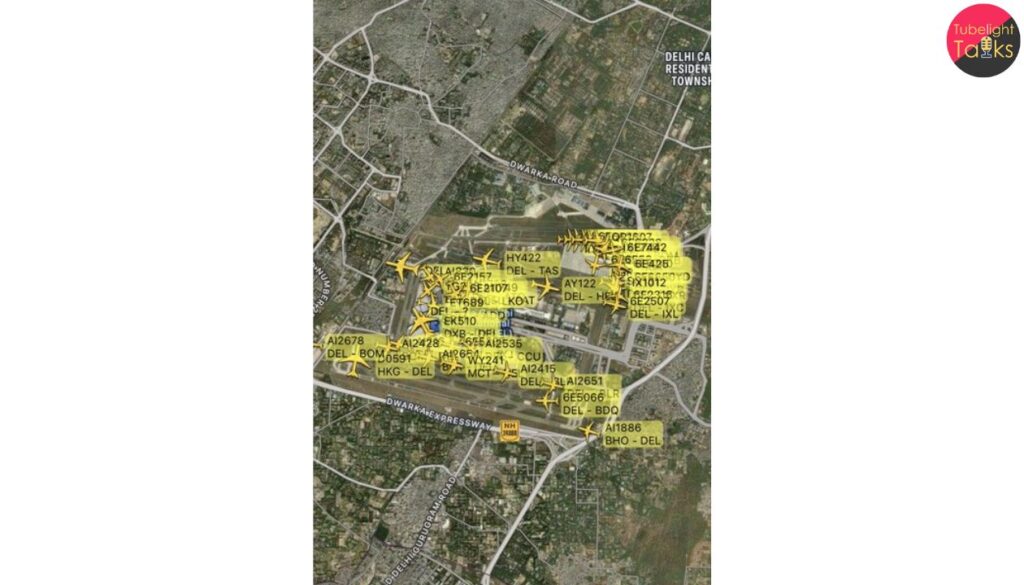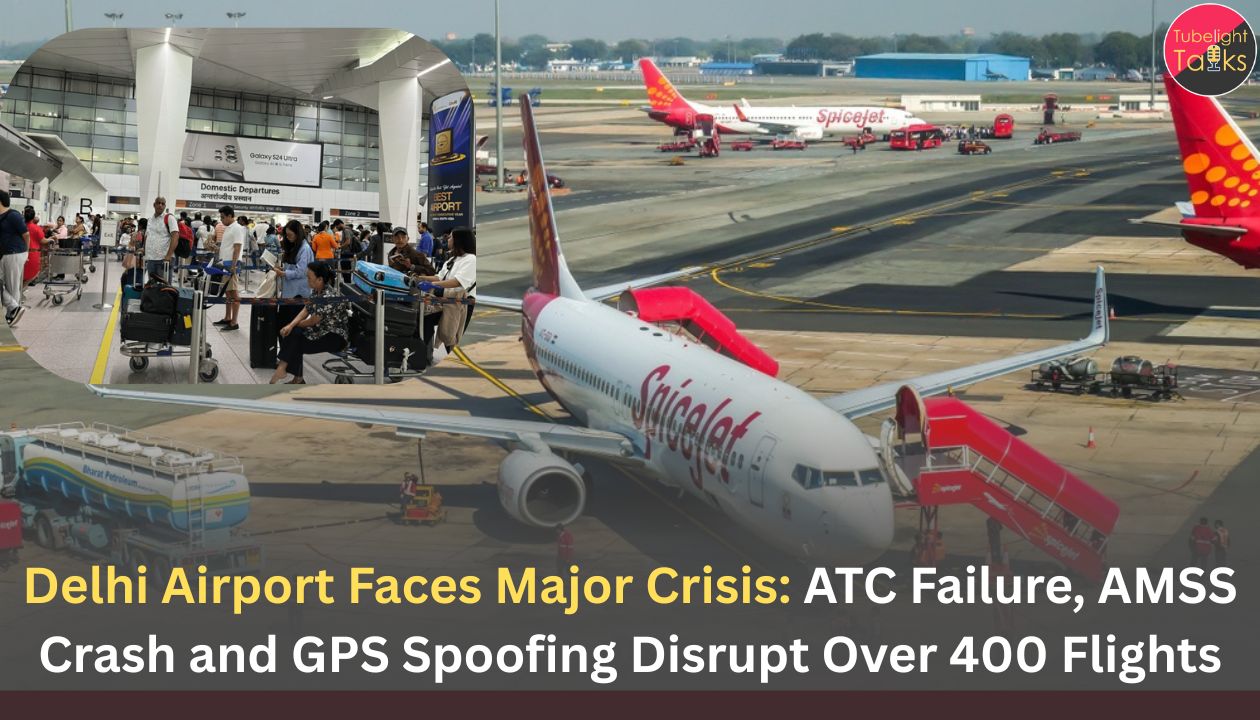Delhi Airport Faces Major Crisis: Delhi’s Indira Gandhi International Airport (IGIA) witnessed an extraordinary aviation crisis this week as a combination of serious technical failures and suspected GPS spoofing incidents brought flight operations to a standstill. Over two days, more than 400 flights were delayed, several were diverted, and thousands of passengers endured long hours of confusion and inconvenience. With multiple systems failing simultaneously—ranging from the Air Traffic Control server to the Automatic Message Switching System (AMSS)—the airport faced one of its most volatile operational periods in recent times.
A Turbulent Week at India’s Busiest Airport: What Sparked the Chaos?
Flight operations at IGI Airport, which handles over 1,500 aircraft movements every day, were thrown into disarray after a major glitch hit the Air Traffic Control (ATC) server. The disruption spread quickly across the northern region, with passengers on various domestic and international routes reporting extended waits both inside terminals and onboard aircraft. The situation worsened when the AMSS—responsible for supplying critical flight-plan data to ATC screens—also malfunctioned, forcing air traffic controllers to process flight plans manually, significantly slowing down the flow of aircraft.
The crisis deepened further when several aircraft approaching Delhi experienced sudden navigation errors linked to suspected GPS spoofing, forcing diversions and increasing airspace congestion.
Key Takeaways: Delhi Airport’s ATC Breakdown, AMSS Failure & GPS Spoofing Disrupt Flight Operations
- Over 400 flights affected across two days; 513 flights delayed on Thursday alone.
- ATC server glitch triggered widespread delays across Delhi and northern India.
- AMSS crash halted automatic flight-plan transmission, forcing manual processing.
- Several flights displayed false navigation data due to suspected GPS spoofing.
- At least seven flights—including IndiGo and Air India—diverted to Jaipur.
- Runway 10/28 partially closed for CAT-III ILS upgrade, increasing dependency on GPS-based RNP approaches.
- Sudden wind direction shift further restricted air traffic flow.
- Airlines issued multiple travel advisories, urging passengers to check flight status before travelling.
ATC Glitch Leads to Region-Wide Flight Disruptions
The week’s troubles began with a severe technical glitch in the ATC system that caused immediate slowdowns across the airport’s departure and arrival operations. The malfunction didn’t just impact Delhi but also triggered cascading delays across several northern states.
Passengers reported being stranded inside planes waiting for take-off clearance, while others complained about long queues near boarding gates. Airlines acknowledged the operational challenges, confirming that technical difficulties in ATC were the root cause behind the widespread congestion.
AMSS Breakdown Creates Unprecedented Pressure on Controllers
As the ATC glitch unfolded, officials confirmed that the Automatic Message Switching System (AMSS)—a core system that provides flight-plan data—was “temporarily unserviceable.” Without automated data flowing into the ATC screens, controllers had to manually prepare every flight plan using whatever information was available, an extremely time-consuming process.
The Airports Authority of India (AAI) stated that the technical teams were working urgently to restore the system, while acknowledging the inconvenience caused to passengers and other stakeholders. Aviation officials described the situation as “uncommon” and “never seen before,” with Delhi ATC facing heavy pressure to maintain safe and orderly operations.
Suspected GPS Spoofing Causes Navigation Errors and Flight Diversions
Amid the ATC and AMSS troubles, Delhi witnessed an alarming new threat—suspected GPS spoofing, marking the first known incidents of such interference at IGI Airport.

GPS spoofing occurs when counterfeit satellite signals overpower real ones, tricking aircraft systems into misjudging their location. In some cases, aircraft may appear hundreds or even thousands of kilometres away from their actual position.
Over the past few days:
- Numerous aircraft approaching Delhi reported anomalous navigation readings.
- Several flights had to abort their landing or divert.
- At least seven flights were diverted to Jaipur on Tuesday evening.
- Delhi ranked second globally in flight disruptions that night, according to Flightradar24.
The situation became even more precarious because Delhi’s main runway, 10/28, is partially closed for an Instrument Landing System (ILS) upgrade to Category III standards. Until the upgrade is complete, aircraft rely on Required Navigation Performance (RNP) procedures, which are GPS-dependent and therefore vulnerable to spoofing.
Reports indicated that spoofed signals were affecting aircraft as far as 60 nautical miles from Delhi, leading to serious concerns over approach accuracy.
Wind Reversal and Runway Constraints Intensify Airspace Congestion
On the same day, a sudden shift in wind direction forced air traffic controllers to reverse runway operations—aircraft had to land from the Dwarka side and take off toward Vasant Kunj. Though all four runways at the airport remained functional, this shift created an additional bottleneck for an already overloaded airspace system.
Officials confirmed that morning departure delays were reaching up to 53 minutes, with an upward trend as congestion deepened.
Airlines Issue Advisories Amid Passenger Frustration
With disruptions intensifying, airlines issued travel advisories asking passengers to stay updated.
IndiGo’s Message to Passengers
IndiGo acknowledged the system-wide delays and urged passengers to track flight status online. The airline assured that both crew and ground staff were working actively to remain supportive during long wait times.
Air India’s Statement
Air India confirmed the ATC-related delays and also reported a temporary “third-party connectivity issue” affecting check-in systems at multiple airports. Though the system was restored later, delays persisted as operations stabilised.
SpiceJet’s Update
SpiceJet also requested passengers to confirm flight status before heading to the airport, citing the ATC and AMSS issues.
DIAL’s Confirmation
Delhi International Airport Limited (DIAL) acknowledged that some airlines faced check-in issues and said it was coordinating with stakeholders to minimise delays and restore normal operations.
Global Pattern of GPS Interference Raises Aviation Safety Concerns
The incidents at Delhi add to a growing global trend of GPS interference affecting civil aviation. Just last month, an Air India flight from Vienna to Delhi diverted to Dubai after spoofed signals over the Middle East disrupted its autopilot and flight-director systems. Historically, such disturbances were limited to conflict zones like West Asia and the Black Sea. Their appearance in Indian airspace marks a concerning development for aviation safety.
Authorities are now investigating the source of the spoofed signals and are working with regulators and experts to ensure long-term protection of navigational systems.
Also Read: China Eastern Airlines Resumes Shanghai‑Delhi Route from November
Spiritual Insight: The Guiding Knowledge of Tatvdarshi Sant Rampal Ji Maharaj Ji
In times of uncertainty and disruption, the divine teachings of Tatvdarshi Sant Rampal Ji Maharaj inspire calmness, clarity, and spiritual strength. His Unique Knowledge explains that true peace comes from devotion to the Supreme God, helping individuals stay balanced even when external situations become unstable. His message encourages truthfulness, patience, and a spiritually disciplined life, guiding society towards inner stability beyond worldly challenges.
What This Week Revealed About Delhi’s Aviation Vulnerabilities
The series of disruptions—including ATC server failures, the AMSS crash, GPS spoofing events, runway limitations, and sudden weather shifts—exposed the fragile balance that keeps operations running at India’s busiest airport. With over 1,500 flights moving each day, even minor system failures can escalate into region-wide turbulence. The events of the week highlight the immediate need for improved cybersecurity, robust backup systems, and stronger navigation safeguards to ensure uninterrupted operations in the future.
FAQs on Delhi Airport ATC Glitch, AMSS Failure and GPS Spoofing Incident
1. What caused massive flight delays at Delhi Airport this week?
Multiple technical failures—including an ATC glitch, AMSS crash, and suspected GPS spoofing—slowed operations, forcing manual flight-plan processing and causing widespread delays.
2. How many flights were affected due to the Delhi Airport disruptions?
Over 400 flights were delayed across two days, with 513 delays reported on Thursday alone.
3. What is GPS spoofing and how did it impact flights near Delhi?
GPS spoofing sends fake satellite signals, causing incorrect navigation data. Several aircraft approaching Delhi faced errors and were forced to divert.
4. Why were flights diverted to Jaipur from Delhi Airport?
Due to suspected GPS spoofing and navigation issues on approach, at least seven flights, including IndiGo and Air India, were diverted to Jaipur.
5. Did runway upgrades contribute to the delays at Delhi Airport?
Yes. Runway 10/28 is partially closed for a CAT-III ILS upgrade, increasing dependency on GPS-based RNP approaches, which became vulnerable during GPS spoofing.










